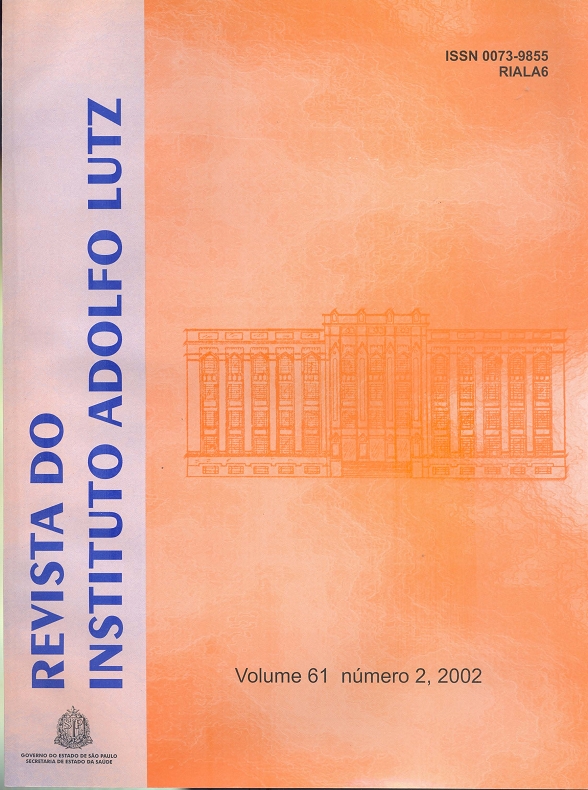Abstract
The rapidly growing mycobacteria, previously classified as Mycobacterium fortuitum complex, has recently been designated M. fortuitum, M. peregrinum, M. chelonae and M. abscessus. The identification of these mycobacteria is important for establishing the proper treatment, because they have different patterns to drugs. Among 3,441 cultures of mycobacteria received in 1999 by the Mycobacteria Laboratory of the Adolfo Lutz Institute, 13 cultures classified as M. fortuitum complex were selected to be studied. The study included isolation of colonies in order to ensure the purity of the cultures, the addition of tests with carbohydrate and citrate, which differentiate the four previously mentioned species and the use of the PCR restriction analysis of hsp65 (PRA) for the analysis of dubious results in conventional tests. In the analysis of the 13 cultures, it was observed that eight showed two types of colonies (smooth
and rough) and the remaining five showed only one type. The identification by PRA technique and by conventional tests agreed to the majority of the strains. The results of this study suggest that the identification of mycobacteria, due to its complexity, should be centralized in Reference Laboratories and implemented with specific tests for each specie in order to give a rapid diagnosis.
References
1. Collins, C.H.; Grange, J.M.; Yates, M.D. Tuberculosis bacteriology: organization and pratice. 2nd London; Butterworth-Heinemann: 1997; 139p.
2. Devallois, A.; Goh, K.S.; Rastogi, N. Rapid identification of mycobacteria to species level by PCR-Restriction Fragment Length polymorphism analysis of the hsp65 gene and proposition of an algorithm to differentiate 34 mycobacterial species. J.Clin.Microbiol. 35:2969-2973, 1997.
3. Euzéby, JP. List of bacterial names with standing in nomenclature [on line] Available from; URL:http://www-sv.cict.fr/bacteriol/. [1999 Oct]
4. Falkinham, III; O, J. Epidemiology of infection by nontuberculous mycobacteria. Clin Microbiol Rev. 9(2):177-215, 1999.
5. Kent, P.T.; Kubica, G.P. Public Health Mycobacteriology. A guide for the level III laboratory. Atlanta; 1985, 207p.
6. Kusunoki, S.; Ezaki, T. Proposal of Mycobacterium peregrinum sp. nov., nom. reg., and elevation of Mycobacterium subsp. abscessus (Kubica et al. ) to species status: Mycobacterium abscessus comb. nov. Int. J. Syst. Bacteriol; 42 (2): 240-245, 1992.
7. Leão, S. C. Infecções por micobactérias de crescimento rápido são mais freqüentes. Sala salélite: MD Millennium Diagnósticos – Consultoria [http://www.saudetotal.com/microbiologia/micobact.htm].13 de maio de 2002.
8. Ministério da Saúde. Fundação Nacional da Saúde. Centro de Referência Professor Hélio Fraga. Manual de Bacteriologia da tuberculose. 2a. ed. Rio de Janeiro; 1994, 115p.
9. Osugui, S. K. et al. Infecções cutâneas causadas por micobactérias de crescimento rápido. in: XXI Congresso Brasileiro de Microbiologia-Simpósio de Micobactérias; 2001 out 21-25; Foz do Iguaçu, PR (Resumo S-066).
10. Ringuet, H. et al. hsp65 Sequencing for Identification of Rapidly Growing Mycobacteria. J. Clin. Microbiol. 37: 852-857, 1999.
11. Seabra, F.P. et al. Ceratite pelo Mycobacterium chelonae após laser in situ ceratomileusis (lasik) estudo microbiológico e histopatológico: relato de um caso-P018. Resumo dos painéis do XXXI Congresso de Oftalmologia. [http://www.abonet.com.Br/abo/644s/painel01.htm]. 13 de maio de 2002.
12. Silcox, V.A.; Good, R.C.; Floyd, M.M. Identification of clinically significant Mycobacterium fortuitum complex isolates. J. Clin. Microbiol; 14 (6): 686-691, 1981.
13. Telenti, A. et. al. Rapid identification of mycobacteria to the species level by polym erase chain reaction and restriction analysis. J Clin Microbiol; 31(2): 175-178, 1993.
14. Tsukamura, M.; Ichikawa, S. Numerical classification of rapidly growing nonphotochromogenic mycobacteria. Microbiol Immunol; 30 (9): 863-882, 1986.
15. Wayne, L.G.; Kubica, G.P. Genus Mycobacterium. Lehmann and Neumann 1896. In Sneath, P.H.A. et al. editors. Bergey’s Manual of Systematic Bacteriology. Baltimore: the Willians &Wilkins; p. 1435-57,1986
16. Winthrop, KL et. al. An outbreak of mycobacterial furunculosis associated with footbaths at a nail salon New England J. Med. 346:1266-371, 2002.
17. Yakrus, M.A. et al. Comparison of methods for identification of Mycobacterium abscessus and M. chelonae isolates. J. Clin Microbiol 39:4103-4110, 2001.

This work is licensed under a Creative Commons Attribution 4.0 International License.
Copyright (c) 2002 Revista do Instituto Adolfo Lutz
